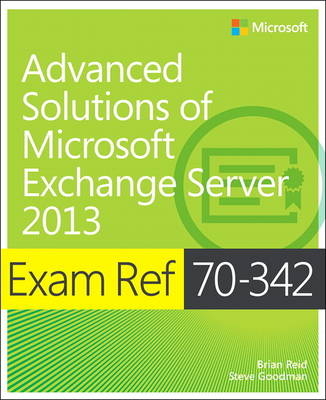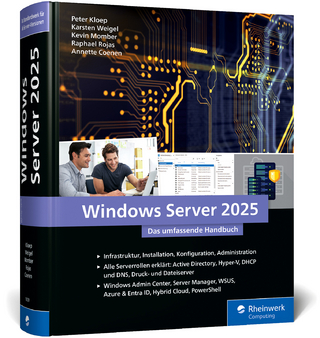
Exam Ref 70-342 Advanced Solutions of Microsoft Exchange Server 2013 (MCSE)
Microsoft Press,U.S. (Verlag)
978-0-7356-9741-6 (ISBN)
- Titel ist leider vergriffen;
keine Neuauflage - Artikel merken
Focus on the expertise measured by these objectives:
Configure, manage, and migrate Unified Messaging
Design, configure, and manage site resiliency
Design, configure, and manage advanced security
Configure and manage compliance, archiving, and discovery solutions
Implement and manage coexistence, hybrid scenarios, migration, and federation
This Microsoft Exam Ref:
Organizes its coverage by exam objectives
Features strategic, what-if scenarios to challenge you
Provides exam preparation tips written by two Exchange Server MVPs
Assumes you have at least three years of experience managing Exchange Servers and have responsibilities for an enterprise Exchange messaging environment
About the Exam
Exam 70-342 is one of two exams focused on Microsoft Exchange Server 2013 skills and knowledge for moving to the cloud, increasing user productivity and flexibility, reducing data loss, and improving data security.
About Microsoft Certification
Passing this exam earns you credit toward a Microsoft Certified Solutions Expert (MCSE) certification that proves your ability to build innovative solutions across multiple technologies, both on-premises and in the cloud.
Exam 70-341 and Exam 70-342 are required for MCSE: Messaging Solutions Expert certification.
See full details at: microsoft.com/learning
Brian Reid, Microsoft MVP and MCM, consults, teaches, and authors books on Exchange Server design, architecture, migration, and troubleshooting. Steve Goodman, Exchange Server MVP, consults on Microsoft Exchange, Office 365, and Lync projects and is a conference speaker and podcast host.
Introduction xv
Microsoft certifications xv
Acknowledgments xv
Free ebooks from Microsoft Press xvi
Microsoft Virtual Academy xvii
Errata, updates, & book support xvii
We want to hear from you xvii
Stay in touch xvii
Preparing for the exam xix
Chapter 1: Configure, manage, and migrate Unified Messaging 1
Understanding Unified Messaging 2
Objective 1.1: Configure Unified Messaging (UM) 4
Configuring an IP gateway 4
Configuring the UM call router 9
Creating and configuring an auto attendant 12
Configuring a call answering rule 18
Designing Unified Messaging for high availability 21
Create a dial plan 23
Objective summary 26
Objective review 26
Objective 1.2: Manage Unified Messaging 27
Assigning a dial plan to a user 27
Moving users between dial plans 28
Enabling and disabling UM features for a user 29
Setting up protected voice mail 33
Configuring UM mailbox policy 35
Managing UM language packs 38
Objective summary 41
Objective review 41
Objective 1.3: Troubleshoot Unified Messaging 42
Troubleshooting and configuring mutual Transport Layer Security (MTLS) 43
Monitoring calls and call statistics 48
Troubleshooting and configuring Quality of Service 51
Troubleshooting SIP communication 53
Objective summary 54
Objective review 55
Objective 1.4: Migrate Unified Messaging 55
Prepare to migrate 56
Planning a migration strategy 57
Planning a coexistence strategy 58
Moving UM mailboxes between sites 58
Redirecting the SIP gateway to Exchange 59
Decommissioning the legacy system 59
Objective summary 60
Objective review 60
Answers 61
Objective 1.1: Thought experiment 61
Objective 1.1: Review 61
Objective 1.2: Thought experiment 62
Objective 1.2: Review 62
Objective 1.3: Thought experiment 63
Objective 1.3: Review 63
Objective 1.4: Thought experiment 63
Objective 1.4: Review 64
Chapter 2: Design, configure, and manage site resiliency 65
Objective 2.1: Manage a site-resilient Database Availability Group (DAG) 65
Planning and implementing Datacenter Activation Coordination (DAC) 66
Given customer node requirements, recommend quorum options 72
Planning cross-site DAG configuration and configuring DAG networks 80
Objective summary 86
Objective review 87
Objective 2.2: Design, deploy, and manage a site-resilient CAS solution 88
Planning site-resilient namespaces 88
Configuring site-resilient namespace URLs 91
Performing steps for site rollover 94
Planning certificate requirements for site failovers 94
Predicting client behavior during a rollover 96
Objective summary 100
Objective review 101
Objective 2.3: Design, deploy, and manage site resilience for transport 101
Configuring MX records for failover scenarios 102
Managing resubmission and reroute queues 107
Planning and configuring send/receive connectors for site resiliency 111
Performing steps for transport rollover 112
Objective summary 115
Objective review 115
Objective 2.4: Troubleshoot site-resiliency issues 116
Resolving quorum issues 117
Troubleshooting proxy and redirection issues 118
Troubleshooting client connectivity 119
Troubleshooting mail flow 119
Troubleshoot datacenter activation 123
Troubleshooting DAG replication 124
Objective summary 126
Objective review 126
Answers 127
Objective 2.1: Thought experiment 127
Objective 2.1: Review 127
Objective 2.2: Thought experiment 128
Objective 2.2: Review 128
Objective 2.3: Thought experiment 129
Objective 2.3: Review 130
Objective 2.4: Thought experiment 131
Objective 2.4: Review 131
Chapter 3: Design, configure, and manage advanced security 133
Objective 3.1: Select an appropriate security strategy 133
Evaluating role-based access control (RBAC) 134
Evaluating BitLocker 138
Evaluating smart cards 142
Evaluating Information Rights Management (IRM) 144
Evaluating S/MIME 145
Evaluating Domain Secure/TLS 155
Objective summary 162
Objective review 163
Objective 3.2: Deploy and manage IRM with Active Directory Rights Management Services (AD RMS) 164
Creating an AD RMS template 165
Creating transport protection rules 169
Creating Outlook protection rules 172
Configuring transport decryption 174
Configuring IRM for discovery 176
Configuring pre-licensing for client access 177
Objective summary 178
Objective review 179
Objective 3.3: Configure and interpret mailbox and administrative auditing 180
Configuring mailbox audit logging 180
Configuring administrative audit logging 181
Interpreting all audit logs 182
Objective summary 185
Objective review 186
Objective 3.4: Troubleshoot security-related issues 186
Determining certificate validity 187
Ensuring proper Certificate Revocation List (CRL) access and placement 189
Ensuring private key availability 192
Troubleshooting failed IRM protection 194
Troubleshooting RBAC 195
Objective summary 196
Objective review 197
Answers 198
Objective 3.1: Thought experiment 198
Objective 3.1: Review 198
Objective 3.2: Thought experiment 199
Objective 3.2: Review 200
Objective 3.3: Thought experiment 200
Objective 3.3: Review 200
Objective 3.4: Thought experiment 201
Objective 3.4: Review 201
Chapter 4: Configure and manage compliance, archiving, and discovery solutions 203
Objective 4.1: Configure and manage an archiving solution 203
Setting up online archiving (Office 365) 205
Creating archive policies 216
Setting up on-premises archiving 220
Planning storage for an archiving solution 220
Objective summary 221
Objective review 222
Objective 4.2: Design and configure Data Loss Prevention (DLP) solutions 222
Setting up pre-built rules 223
Setting up custom rules 227
Designing a DLP solution to meet business requirements 231
Setting up custom policies 231
Objective summary 233
Objective review 234
Objective 4.3: Configure and administer Message Records Management (MRM) 234
Designing retention policies 234
Configuring retention policies 236
Creating and configuring custom tags 237
Assigning policies to users 239
Configuring the Managed Folder Assistant 240
Removing and deleting tags 241
Objective summary 243
Objective review 244
Objective 4.4: Perform eDiscovery 244
Planning and delegating RBAC roles for eDiscovery 245
Enabling a legal/litigation hold 246
Performing a query-based In-Place Hold 247
Designing and configuring journaling 249
Performing multi-mailbox searches in Exchange Administration Center (EAC) 254
Evaluating how to integrate In-Place federated searches with Microsoft SharePoint 257
Objective summary 259
Objective review 259
Objective 4.5: Implement a compliance solution 260
Designing and configuring transport rules for ethical walls 260
Configuring MailTips 264
Creating, configuring, and deploying message classifications 266
Designing and configuring transport rules to meet specified compliance requirements 268
Objective summary 271
Objective review 271
Answers 272
Objective 4.1: Thought experiment 272
Objective 4.1: Review 272
Objective 4.2: Thought experiment 273
Objective 4.2: Review 273
Objective 4.3: Thought experiment 274
Objective 4.3: Review 274
Objective 4.4: Thought experiment 275
Objective 4.4: Review 275
Objective 4.5: Thought experiment 276
Objective 4.5: Review 276
Chapter 5: Implement and manage coexistence, hybrid scenarios, migration, and federation 279
Objective 5.1: Establish coexistence with Exchange Online 280
Deploying and managing hybrid configuration 280
Evaluating limitations of the Hybrid Configuration Wizard 291
Configuring requirements for single sign-on (SSO) 293
Designing and configuring Active Directory Federation Services (AD FS) 295
Objective summary 304
Objective review 304
Objective 5.2: Deploy and manage Exchange federation 305
Managing federation trusts with Microsoft federation gateway 306
Managing sharing policies 309
Designing certificate and firewall requirements 316
Managing organization relationships 316
Objective summary 318
Objective review 319
Objective 5.3: Implement on-premises coexistence with legacy systems 320
Planning namespaces for coexistence 320
Configuring proxy redirect 323
Planning firewall configuration for coexistence 323
Planning for mail flow requirements 325
Objective summary 326
Objective review 327
Objective 5.4: Set up a cross-forest coexistence solution 327
Setting up cross-forest availability 328
Designing certificate and firewall requirements 330
Setting up cross-forest mail flow 330
Designing and configuring AutoDiscover 331
Setting up shared namespaces 333
Objective summary 337
Objective review 337
Objective 5.5: Migrate legacy systems 338
Determining transition paths to Exchange 338
Migrating public folders 339
Migrating mailboxes 341
Upgrading policies 343
Planning to account for discontinued features 343
Transitioning and decommissioning server roles 344
Objective summary 345
Objective review 345
Objective 5.6: Troubleshoot issues associated with hybrid scenarios, coexistence, migration, and federation 346
Troubleshooting transport 347
Troubleshooting Exchange federation trust and organization relationships 348
Troubleshooting SSO/AD FS 349
Troubleshooting DirSync 349
Troubleshooting cross-forest availability 350
Objective summary 351
Objective review 351
Answers 351
Objective 5.1: Thought experiment 351
Objective 5.1: Review 352
Objective 5.2: Thought experiment 353
Objective 5.2: Review 353
Objective 5.3: Thought experiment 354
Objective 5.3: Review 354
Objective 5.4: Thought experiment 355
Objective 5.4: Review 355
Objective 5.5: Thought experiment 356
Objective 5.5: Review 356
Objective 5.6: Thought experiment 357
Objective 5.6: Review 357
| Erscheint lt. Verlag | 12.2.2015 |
|---|---|
| Verlagsort | Redmond |
| Sprache | englisch |
| Maße | 189 x 229 mm |
| Gewicht | 660 g |
| Themenwelt | Informatik ► Betriebssysteme / Server ► Windows |
| Informatik ► Betriebssysteme / Server ► Windows Server | |
| Informatik ► Weitere Themen ► Zertifizierung | |
| ISBN-10 | 0-7356-9741-8 / 0735697418 |
| ISBN-13 | 978-0-7356-9741-6 / 9780735697416 |
| Zustand | Neuware |
| Informationen gemäß Produktsicherheitsverordnung (GPSR) | |
| Haben Sie eine Frage zum Produkt? |
aus dem Bereich


